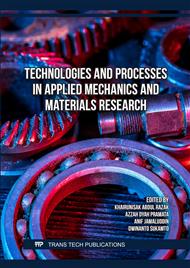[1]
T. Vilkner, A. Shivji, A. Manz, Dry powder injection on chip, Lab Chip. 5 (2005) 140–145.
DOI: 10.1039/b412566p
Google Scholar
[2]
B.E. Jones, The filling of powders into two-piece hard capsules, Int. J. Pharm. 227 (2001) 5–26.
Google Scholar
[3]
G.I. Tardos, Q. Lu, Precision dosing of powders by vibratory and screw feeders: An experimental study, Adv. Powder Technol. 7 (1996) 51–58.
DOI: 10.1016/s0921-8831(08)60891-2
Google Scholar
[4]
W. Chen, M. Hou, K. Lu, Z. Jiang, L. Lam, Retardation and transitions of dilute and dense granular flows in a vertical pipe induced by electric fields, Appl. Phys. Lett. 80 (2002) 2213–2215.
DOI: 10.1063/1.1459767
Google Scholar
[5]
S. Matsusaka, K. Yamamoto, H. Masuda, Micro-feeding of a fine powder using a vibrating capillary tube, Adv. Powder Technol. 7 (1996) 141–151.
DOI: 10.1016/s0921-8831(08)60509-9
Google Scholar
[6]
S. Yang, J.R.G. Evans, Metering and dispensing of powder; the quest for new solid freeforming techniques, Powder Technol. 178 (2007) 56–72.
DOI: 10.1016/j.powtec.2007.04.004
Google Scholar
[7]
X. Lu, S. Yang, J.R.G. Evans, Studies on ultrasonic microfeeding of fine powders, J. Phys. D. Appl. Phys. 39 (2006) 2444–2453.
DOI: 10.1088/0022-3727/39/11/020
Google Scholar
[8]
L. Qi, X. Zeng, J. Zhou, J. Luo, Y. Chao, Stable micro-feeding of fine powders using a capillary with ultrasonic vibration, Powder Technol. 214 (2011) 237–242.
DOI: 10.1016/j.powtec.2011.08.015
Google Scholar
[9]
I.M. Zainuddin, M. Yasuda, T. Horio, S. Matsusaka, Experimental study on powder flowability using vibration shear tube method, Part. Part. Syst. Charact. 29 (2012) 8–15.
DOI: 10.1002/ppsc.201100052
Google Scholar
[10]
D. Barletta, M. Poletto, Aggregation phenomena in fluidization of cohesive powders assisted by mechanical vibrations, Powder Technol. 225 (2012) 93–100.
DOI: 10.1016/j.powtec.2012.03.038
Google Scholar
[11]
S. Chianrabutra, B.G. Mellor, S. Yang, A dry powder material delivery device for multiple material additive manufacturing, 25th Annu. Int. Solid Free. Fabr. Symp. � An Addit. Manuf. Conf. SFF 2014. (2014) 36–48.
Google Scholar
[12]
C. Wei, H. Gu, X. Zhang, Y. hui Chueh, L. Li, Hybrid ultrasonic and mini-motor vibration-induced irregularly shaped powder delivery for multiple materials additive manufacturing, Addit. Manuf. 33 (2020) 101138.
DOI: 10.1016/j.addma.2020.101138
Google Scholar
[13]
X. Zhang, C. Wei, Y.H. Chueh, L. Li, An integrated dual ultrasonic selective powder dispensing platform for three-dimensional printing of multiple material metal/glass objects in selective laser melting, J. Manuf. Sci. Eng. Trans. ASME. 141 (2019).
DOI: 10.1115/1.4041427
Google Scholar
[14]
Y. Jiang, S. Matsusaka, H. Masuda, T. Yokoyama, Evaluation of flowability of composite particles and powder mixtures by a vibrating capillary method, J. Chem. Eng. Japan. 39 (2006)
DOI: 10.1252/jcej.39.14
Google Scholar
[15]
H. Wu, D. Pritchet, S. Wolff, J. Cao, K. Ehmann, P. Zou, A VIBRATION-ASSISTED POWDER DELIVERY SYSTEM FOR ADDITIVE MANUFACTURING - An experimental investigation -, Addit. Manuf. 34 (2020) 101170.
DOI: 10.1016/j.addma.2020.101170
Google Scholar
[16]
T. Stichel, T. Laumer, T. Baumüller, P. Amend, S. Roth, Powder layer preparation using vibration-controlled capillary steel nozzles for additive manufacturing, Phys. Procedia. 56 (2014) 157–166.
DOI: 10.1016/j.phpro.2014.08.158
Google Scholar



